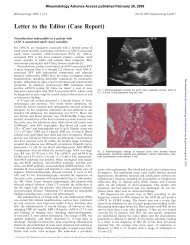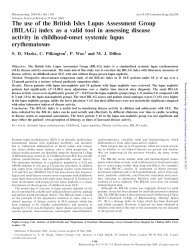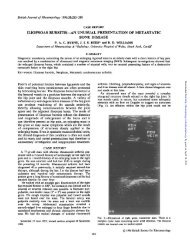Concise report - Rheumatology
Concise report - Rheumatology
Concise report - Rheumatology
You also want an ePaper? Increase the reach of your titles
YUMPU automatically turns print PDFs into web optimized ePapers that Google loves.
<strong>Concise</strong> <strong>report</strong> doi:10.1093/rheumatology/keq253<br />
Usefulness of a centralized system of data<br />
collection for the development of an intearnational<br />
multicentre registry of spondyloarthritis<br />
Ruxandra Schiotis 1,2 , Pilar Font 1 , Alejandro Escudero 1 , Pedro Zarco 3 ,<br />
Raquel Almodovar 3 , Jordi Gratacós 4 , Juan Mulero 5 , Xavier Juanola 6 ,<br />
Carlos Montilla 7 , Estefanía Moreno 8 , Rafael Ariza Ariza 9 and<br />
Eduardo Collantes-Estevez 1 on behalf of REGISPONSER working group<br />
Abstract<br />
Objective. To present the usefulness of a centralized system of data collection for the development of an<br />
international multicentre registry of SpA.<br />
Method. The originality of this registry consists in the creation of a virtual network of researchers in a<br />
computerized Internet database. From its conception, the registry was meant to be a dynamic acquiring<br />
system.<br />
Results. REGISPONSER has two developing phases (Conception and Universalization) and gathers several<br />
evolving secondary projects (REGISPONSER-EARLY, REGISPONSER-AS, ESPERANZA and<br />
RESPONDIA). Each sub-project answered the necessity of having more specific and complete data of<br />
the patients even from the onset of the disease so, in the end, obtaining a well-defined picture of SpAs<br />
spectrum in the Spanish population.<br />
Conclusion. REGISPONSER is the first dynamic SpA database composed of cohorts with a significant<br />
number of patients distributed by specific diagnosis, which provides basic specific information of the subcohorts<br />
useful for patients’ evaluation in rheumatology ambulatory consulting.<br />
Key words: Multicentre registry, Spondyloarthropathies, REGISPONSER.<br />
Introduction<br />
<strong>Rheumatology</strong> Advance Access published September 7, 2010<br />
RHEUMATOLOGY<br />
Health-care managers need reliable instruments to help<br />
them distribute and allocate health and social resources<br />
objectively and fairly. These instruments should be<br />
1 <strong>Rheumatology</strong> Department, Hospital Universitario ‘Reina Sofía’ and<br />
IMIBIC (Instituto Maimonides de Investigación Biomedica de<br />
Cordoba), Córdoba, 2 <strong>Rheumatology</strong> Department, University of<br />
Medicine and Pharmacy ‘Iuliu Hatieganu’, Cluj-Napoca, Romania,<br />
3 <strong>Rheumatology</strong> Department, H. FUNDACIÓN de Alcorcón,<br />
4 <strong>Rheumatology</strong> Department, H. Parc Taulí, Badalona, 5 <strong>Rheumatology</strong><br />
Department, H. U. Puerta de Hierro, Madrid, 6 <strong>Rheumatology</strong><br />
Department, H. U. Bellvitge, Barcelona, 7 <strong>Rheumatology</strong> Department,<br />
H. Virgen de la Vega, Salamanca, 8 <strong>Rheumatology</strong> Department, H. San<br />
Rafael, Barcelona and 9 <strong>Rheumatology</strong> Department, Hospital<br />
Universitario Macarena, Sevilla, Spain.<br />
Submitted 8 April 2010; revised version accepted 1 July 2010.<br />
Correspondence to: Eduardo Collantes-Estévez, Servicio de<br />
Reumatología, Hospital Universitario ‘Reina Sofía’, Avda.<br />
Menendez Pidal s/n, 14004 Córdoba, Spain.<br />
E-mail: eduardo.collantes.sspa@juntadeandalucia.es<br />
flexible and provide real-time data, and they should<br />
easily incorporate any change in practice and scientific<br />
knowledge. Disease registries are most suitable for this<br />
task, as they provide real-time data on the frequency,<br />
geographic and temporary distribution, as well as on the<br />
pattern of the disease [1]. They inform about the case mix<br />
in different locations and provide an enlightening tool for<br />
assessing the impact of the disease and clinical practice<br />
variability. Furthermore, disease registries are an ideal<br />
source of random samples for cohort studies or for<br />
case–control studies, the correct setting to test medical<br />
hypothesis [2]. Our experience from the registries developed<br />
over the past few years has shown us their usefulness<br />
in describing the epidemiological aspects, clinical<br />
pattern, disease activity, structural damage, response to<br />
therapy, impairment degree in quality of life and<br />
socio-economic impact associated with inflammatory<br />
rheumatic diseases, in our case focused on patients<br />
with SpAs.<br />
! The Author(s) 2010. Published by Oxford University Press on behalf of The British Society for <strong>Rheumatology</strong>.<br />
This is an Open Access article distributed under the terms of the Creative Commons Attribution Non-Commercial License (http://creativecommons.org/licenses/by-nc/2.5), which permits unrestricted<br />
non-commercial use, distribution, and reproduction in any medium, provided the original work is properly cited. 1<br />
CLINICAL<br />
SCIENCE<br />
Downloaded from<br />
http://rheumatology.oxfordjournals.org/ by guest on December 21, 2012
Ruxandra Schiotis et al.<br />
REGISPONSER, which is a dynamic database registry,<br />
was initiated in April 2004, by SpAs study group of the<br />
Spanish Society of <strong>Rheumatology</strong> (GRESSER). Thereby,<br />
REGISPONSER (Registro Español de Espondiloartritis<br />
de la Sociedad Española de Reumatologia), that is, The<br />
Spanish National Registry of SpAs, is composed of a large<br />
enough cohort of patients to enable us to determine a<br />
well-defined picture of patient characteristics and the progress<br />
of their diseases, even from onset.<br />
Methods<br />
The originality of this registry has been the creation of a<br />
virtual network of researchers set upon a computerized<br />
Internet database accessible to all participating members,<br />
irrespective of which city or country they belong to (http://<br />
regisponser.ser.es/). Each centre has individual access to<br />
the registry, either for investigation or for managing<br />
purposes. The online application is easily accessible via<br />
a standard Internet browser. No additional software is<br />
needed to be installed on the user’s computer. Once the<br />
self-administered patients’ validated questionnaires are<br />
achieved, the data are introduced in the electronic clinical<br />
research form (e-CRF), under strict quality control by filters<br />
that detect data inconsistencies, for assuring the uniformity<br />
of data collection. The information contained in<br />
these e-CRFs was agreed with all the investigators<br />
before starting the database. The e-CRF provides the<br />
basic minimum data set required for the complete definition<br />
of the patient and his illness, according to the recommendations<br />
of ASAS (Assessment of Ankylosing<br />
Spondylitis International Society) [3] (Table 1). A specific<br />
code (login and password) is assigned to each investigator<br />
to access the e-CRF and random codes are given to<br />
each introduced case. In this way, the system meets the<br />
rules of the protection of personal data. The system performs<br />
an automatic log out after a predefined period of the<br />
user’s inactivity. This function prevents abuse of the<br />
system if the user forgets to log off. All submitted data<br />
are encrypted and collected in a central computer,<br />
where they are safely stored in the database. The data<br />
can be exported for authorized users as a local database<br />
for further processing. This study was approved by the<br />
Committee of Ethical and Sanitary Investigation of Reina<br />
Sofia University Hospital. Each patient has signed an informed<br />
consent at inclusion in REGISPONSER, according<br />
to the fundamental principles established in the<br />
Declaration of Human Rights in Helsinki.<br />
Results<br />
Phase I<br />
At its first beginning (2004–05) the registry (REGISPONSER I)<br />
was comprised of 12 reference Spanish rheumatology departments<br />
selected from all the centres that agreed to<br />
participate in the project, based on their experience in<br />
treating SpA patients. These centres, from eight different<br />
cities, represent a broad socio-demographic spectrum of<br />
the population attended at the Spanish Health System.<br />
The average population covered by the participating hospitals<br />
is 800 000 (range 300 000–1 100 000), and includes<br />
urban and rural zones. The participating rheumatologists<br />
were asked to include all consecutive patients fulfilling the<br />
inclusion criteria up to a minimum of 100 per centre.<br />
The main purposes of REGISPONSER I were to create,<br />
develop and exploit the Spanish national registry of patients<br />
with SpA and its specific objective was to determine<br />
the characteristics of the Spanish patients with SpA<br />
(socio-demographic, clinical, radiological, laboratory and<br />
treatment features) in a cross-sectional study (photography).<br />
REGISPONSER I included 1379 patients fulfilling<br />
European Spondyloarthropathy Study Group (ESSG) classification<br />
criteria and the results were already published<br />
[4]. The results of this project were: (i) development of a<br />
useful computer application; (ii) user-friendly patient data<br />
processing obtained from different centres; and (iii) direct<br />
information of the characteristics of the Spanish SpA patients,<br />
although the most important goal achieved by<br />
REGISPONSER I has been the growing interest of the<br />
Spanish rheumatologists in SpA and so, thereby ‘increasing<br />
the visibility of SpA in Spain’.<br />
Phase II<br />
After the data-acquiring system was validated, an invitation<br />
was sent to all those Spanish rheumatology centres<br />
that met the minimum requirement criteria, and hence<br />
other 19 centres joined the project. Thus, by the end of<br />
March 2007, 2367 patients were included in the registry.<br />
This phase of the project is known as Universalization.<br />
REGISPONSER II helped to increase knowledge of SpAs<br />
in the Spanish population and to incite the development of<br />
new projects. REGISPONSER II collected information<br />
from 31 Spanish rheumatologic departments, from 31 different<br />
hospitals belonging to 19 provinces that cover a<br />
wide spectrum of the Spanish habitants with different<br />
social, economic and occupational conditions.<br />
Continuous development<br />
REGISPONSER II is a dynamic project that collects standardized<br />
socio-demographic, clinical, biological, radiological,<br />
genetic and treatment data relevant to SpAs<br />
spectrum. The authenticity of this project consists in the<br />
requirement that all the patients included to fulfil both<br />
ESSG and Amor criteria for SpA. Several studies were<br />
developed from REGISPONSER II and the results have<br />
already been published [5–7]. In addition to these published<br />
results, REGISPOSER II revealed some interesting<br />
facts: first, by increasing the sample, clinical and demographic<br />
outcomes obtained in REGISPONSER I did not<br />
change significantly [8]; and secondly, there was an unacceptable<br />
delay of 8.6 years in SpA diagnosis in Spain.<br />
Therefore, we created an ambitious project that involves<br />
both general practitioners and rheumatologists called<br />
ESPERANZA, with the purpose of early detection of SpA.<br />
The goals were to create and establish units for the<br />
early management of patients with SpAs and to develop<br />
a communication system between general practitioners<br />
2 www.rheumatology.oxfordjournals.org<br />
Downloaded from<br />
http://rheumatology.oxfordjournals.org/ by guest on December 21, 2012
TABLE 1 Data collected by the e-CRF<br />
Treatment in the<br />
last 2 weeks Working conditions<br />
Clinical data<br />
Variables of disease assessment<br />
Socio-demographic data<br />
First signs and symptoms Comorbidities Diagnostic data<br />
Date of birth BASDAI NSAIDs Fully employed<br />
Gender Date of first symptoms Hypertension Year of diagnostic BASFI DMARDs Work disability<br />
Race Articular symptoms Diabetes Clinic form Mander enthesis index anti-TNF-a Unemployed<br />
Marital status Extra-articular symptoms related to Ischaemic heart disease HLA-B27 Metrological index: mod.Schober<br />
the disease (uveitis, IBD, psoriasis) Dislipidaemia<br />
occiput/tragus to wall distance,<br />
Gastro-duodenal ulcer<br />
fingers to floor distance, cervical<br />
rotation, lateral spinal flexion, chest<br />
expansion<br />
Profession Associated infection (urethritis, Cerebral-vascular desease ESSG criteria BASRI-total<br />
balanitis, cervicitis)<br />
Periphery vascular disease<br />
m-SASSS<br />
Study degree Trauma associated Chronic obstructive<br />
Amor criteria DNA bank for selected groups<br />
bronchopneumopathy<br />
Average income Family history of SpA Infections Hip involvement NPJ/NSJ<br />
Living conditions Treatment before the inclusion in Neoplasm VAS-patient<br />
the registry<br />
Liver disease VAS-physician<br />
Depression VAS-night back pain<br />
Cytopenias ASQoL<br />
Renal failure SF-12<br />
Amyloidosis ESR<br />
Atlanto-axoidal subluxation CRP<br />
Demyelinating diseases MRI SI joint and spine for selected<br />
groups<br />
Drinking<br />
Smoking<br />
Fibromyalgia<br />
Usefulness of a centralized system of data collection<br />
www.rheumatology.oxfordjournals.org 3<br />
m-SASSS: modified stoke AS spine score; NPJ: number of painful joints; NSJ: number of swollen joints; VAS: visual analogue scale; ASQoL: AS quality of life; SF-12: short form health<br />
survey.<br />
Downloaded from<br />
http://rheumatology.oxfordjournals.org/ by guest on December 21, 2012
Ruxandra Schiotis et al.<br />
FIG. 1Evolution of REGISPONSER registry.<br />
REGISPONSER II<br />
Universalization (until March<br />
2007)<br />
31 centres<br />
2367 patients<br />
prevalence of fibromyalgia on SpA<br />
patients<br />
work disability in AS patients<br />
relationship between spinal mobility<br />
and disease activity, function, quality<br />
of life and radiology<br />
hip epidemiology in SpA<br />
REGISPONSER-AS<br />
31 centres<br />
529 AS patients<br />
and rheumatologists for early referral of patients with suspected<br />
spondylitis, according to the following criteria: patients<br />
3 and 30<br />
min and improvement with exercise; (ii) asymmetrical oligoarthritis<br />
of the lower limbs (at least one and maximum<br />
four big joints in the lower limbs affected asymmetrically);<br />
and (iii) other suspicious criteria as: rachialgia plus at least<br />
one of following: psoriasis; IBD; acute anterior uveitis;<br />
family history of SpA, psoriasis, IBD or anterior uveitis;<br />
Rx sacroiliitis; and HLA-B27 positivity. At present there<br />
are 25 rheumatologic centres and 2099 general practitioners<br />
involved in the programme that has derived 898 new<br />
patients. Parts of the results have been <strong>report</strong>ed during<br />
the 2009 EULAR Congress [9].<br />
The main advantage of REGISPONSER II is that it provides<br />
a source of well-characterized patients treated in<br />
Spanish rheumatology centres, which may be used as<br />
database for new prospective projects (Fig. 1). Thus, a<br />
number of such new prospective secondary projects are<br />
now in progress: (i) REGISPONSER-EARLY that is comprised<br />
of a cohort of patients with SpAs with
can also be evaluated, as can the implication of genetic<br />
factors in disease evolution and in response to different<br />
therapies. Furthermore, implementation of this project has<br />
helped raise the profile of SpA, by increasing the knowledge<br />
and interest of the participating rheumatologists in<br />
these interesting conditions.<br />
Conclusion<br />
REGISPONSER is the first dynamic SpA database composed<br />
of cohorts with a significant number of patients<br />
distributed by specific diagnosis, which provides basic<br />
specific information of the sub-cohorts useful for patients’<br />
evaluation in rheumatology ambulatory consulting.<br />
<strong>Rheumatology</strong> key messages<br />
. REGISPONSER increased awareness of SpAs.<br />
. REGISPONSER provides a characterization of the<br />
Spanish SpA patients, useful for their evaluation in<br />
ambulatory consulting.<br />
Acknowledgements<br />
Funding: This work was supported by The Spanish<br />
Foundation of <strong>Rheumatology</strong> (FER), by an unrestricted<br />
grant thanks to the financial collaboration of three<br />
pharmaceutical companies that participated equally in<br />
the development of REGISPONSER, and we are very<br />
grateful to Abbott, Schering-Plough and Wyeth for their<br />
huge contribution. ESPERANZA Program has been<br />
financed through an unrestricted grant by the FER,<br />
thanks to the financial collaboration of Wyeth<br />
Pharmaceuticals. Funding to pay the Open Access<br />
publication charges for this article was provided by<br />
Universidad de Córdoba.<br />
Disclosure statement: The authors have declared no<br />
conflicts of interest.<br />
References<br />
1 Lynge E. Implication for epidemiology of disease registers.<br />
Public Health Rev 1993–94;21:263–70.<br />
2 Zink A, Listing J, Klindworth C, Zeidler H. The National<br />
database of the German Collaborative Arthriris Centres: I.<br />
Usefulness of a centralized system of data collection<br />
Structure, aims, and patients. Ann Rheum Dis 2001;60:<br />
199–206.<br />
3 van der Heijde D, Calin A, Dougados M, Khan MA, van der<br />
Linden S, Bellamy N. Selection of instruments in the core<br />
set for DC-ART, SMARD, physical therapy, and clinical<br />
record keeping in ankylosing spondylitis. Progress <strong>report</strong><br />
of the ASAS Working Group. Assessments in Ankylosing<br />
Spondylitis. J Rheumatol 1999;26:951–4.<br />
4 Collantes E, Zarco P, Muñoz E et al. Disease pattern of<br />
spondyloarthropathies in Spain: description of the first<br />
national registry (REGISPONSER) extended <strong>report</strong>.<br />
<strong>Rheumatology</strong> 2007;46:1309–15.<br />
5 Ariza-Ariza R, Hernandez-Cruz B, Collantes E. et al.<br />
Work disability in patients with ankylosing spondylitis.<br />
J Rheumatol 2009;36:2512–6.<br />
6 Almodóvar R, Zarco P, Collantes E et al. Relationship<br />
between spinal mobility and disease activity, function,<br />
quality of life and radiology in a cross-sectional<br />
Spanish registry of spondyloarthropathies<br />
(REGISPONSER). Clin Exp Rheumatol 2009;27:439–45.<br />
7 Almodovar R, Carmona L, Zarco P et al. Fybromyalgia in<br />
patients with ankylosing spondylitis: prevalence and utility<br />
of the measures of activity, function and radiological<br />
damage. Clin Exp Rheumatol (in press).<br />
8 Miranda García MD, Font Ugalde P, Muñoz Gomariz E,<br />
Collantes E por Regisponser. The National<br />
Spondiloarthropathies Registry of the Spanish Society of<br />
<strong>Rheumatology</strong> (REGISPONSER). Descriptive Study of<br />
2367 Spanish Patients. Reumatología Clinica 2008;<br />
4(Suppl. 4):48–55.<br />
9 Almodóvar R, Zarco P, Collantes E et al. Agreement<br />
between primary care physicians and rheumatologist<br />
regarding predefined referral criteria in patients with<br />
spondiloarthropaties. Ann Rheum Dis 2009;68(Suppl. 3):<br />
647.<br />
10 Rojas-Vargas M, Muñoz-Gomariz E, Escudero A et al.<br />
on behalf REGISPOSER working group. First signs and<br />
symptoms of spondyloarthritis. Data from an inception<br />
cohort with a disease course of two years or less<br />
(REGISPONSER- Early). <strong>Rheumatology</strong> 2009;48:404–9.<br />
11 Vazquez-Mellado Cervantes J, Font Ugalde P, Muñoz<br />
Gomariz E, Collantes E. RESPONDIA. Iberoamerican<br />
Spondyloarthritis: Registry What Is It, Who Are We, What<br />
We Do? General Methods. Reumatología Clinica 2008;<br />
4(Suppl. 4):S17–22.<br />
12 Vander Cruyssens B, Muñoz-Gomariz E, Font P et al.<br />
Hip involvement in ankylosing spondylitis: epidemiology<br />
and risk factors associated with hip replacement surgery.<br />
<strong>Rheumatology</strong> 2010;49:73–81.<br />
www.rheumatology.oxfordjournals.org 5<br />
Downloaded from<br />
http://rheumatology.oxfordjournals.org/ by guest on December 21, 2012















